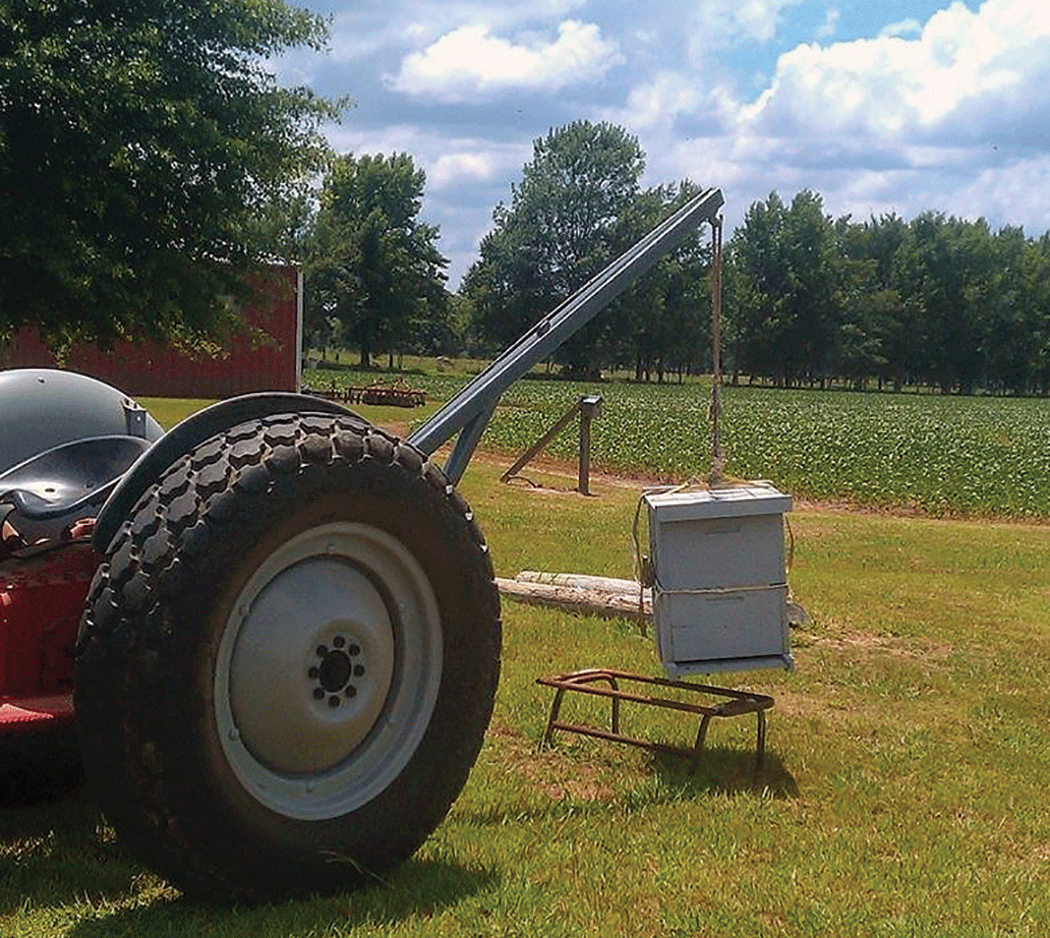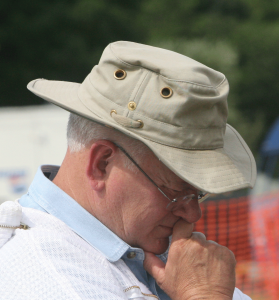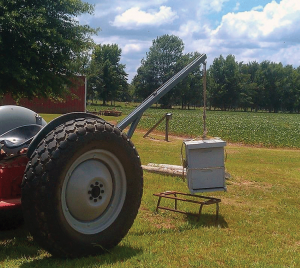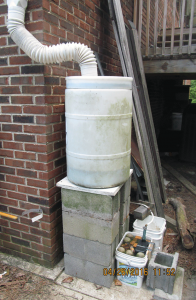By: James Tew
Some thoughts on Senior Citizen Beekeeping.
What is a healthy colony anway?
Your new package bees should be thriving by now. Are they?
Odds and Ends – A rainwater device for watering bees.
Why are most bee suits white?
Senior citizen beekeepers
At this point, all of you young athletic beekeepers can skip to the following section on Healthy Colonies. Not
much for you here at this point, but certainly you can expect lifestyle changes in years to come. I didn’t think this aging thing would happen to me either.
A few weeks ago, I truly frightened myself – alone – in my own beeyard. I mean it was that dark dread of deep
fear that happened quickly, but was strangely not totally unexpected. The cause? After lifting a full deep super, I was certain that I had seriously reinjured my left shoulder – again.
Knowing me, I probably wrote about it in an earlier BC article, but approximately three years ago, I had my left shoulder surgically repaired/rebuilt – and, no, I do not know what I did to cause myself so much damage in such a small spot. I just tore up my left shoulder.
As has become typical when preparing for the few surgical procedures that I have experienced, my surgeon assured me that all was typical and within eight weeks I would once again have a 64 year-old shoulder1. It’s never typical and it always takes longer to recover that the estimates given. I underwent the procedure and upon awakening was told that the damage was extensive and required extensive repair. My recovery period would not be eight weeks, but more likely a year. With therapy and time, about a year later I was okay. Another year and I felt that I was back to as normal as I would ever be. Now, as I near 68, I am very, very happy that I had the work done. Even requiring a year’s recovery, if necessary, I would do it again.
My questionable moment
In the beeyard, a few weeks ago, as I have done so often in recent years, I needed to take honey off a winterkill colony. I seem to have this attitude that leaving a ridiculous amount of honey on colony preparing for Winter will somehow save the Winter day. All too often, it does not. Varroa and the effects of Varroa continue to be my greatest Winter challenge – no matter how much honey is on the wintering colony.
One dead colony had a full deep super on top of the typical two deep supers that housed the dead cluster. I felt that it was time. I was fully healed; what better time to reemploy my newly rebuild shoulder joint. I broke the super free of its propolis seal and hefted the heavy box.
The weight of the nearly 100 pound box was immediate overloading and threatening. The trip to the worktable was short but still too long. The strain and discomfort was immediate as was the deep, dark dread. Oh no. Oh no. Was I going to be required to go through all that surgical work again? Could my talented surgeons repair, yet again, my shoulder joint? By nightfall, the discomfort was readily apparent and I confessed to my wife – who immediately questioned my sanity but after all, I am a beekeeper.
The following day, my pain was no worse and during the following four to five days, I seemed to have recovered as much as possible. I am once again okay. I think I dodged a surgical bullet, but that event was a stern, stern warning. In the beeyard, I can no longer do what I have done thousands of times – pick up heavy boxes.
My no-can-do-ever-again list
I added lifting full supers to my growing list of things I should never do again. Presently the list is: no water skiing, no bowling, no elite roller coasters, no jump roping, and no extensive paint jobs that requires a ladder. To the list I add – no dead-lifting heavy supers in the beeyard – even if someone else is present. So how will ever remove a honey crop?
Frame by frame
I could take out individual frames. Yes, that will work and yes, and I will try this procedure, but I will continue to explore alternatives. But there must be other ways to lift supers.
For other reasons, years ago, I purchased a subcompact Kabota tractor with a front loader. I will explore setting the blade edge of the loader bucket at the very bottom edge of the super, break the super loose, and slide it into the loader bucket. (I’m sure the bees will not notice any of this.) As clumsy as I know it will be, I would (theoretically) use this clumsy machine as I would use two younger shoulders.
For Senior Citizen beekeepers
Nearly any attribute of a yard that is suitable for Senior Citizens will usually be okay for any beekeeper. While there are many, many more older beekeepers still working with bees, I am personally acquainted with two 90+ year-old Alabama beekeepers who are still in the apiary. Beekeepers like that are reassuring to the rest of us.
In the perfect yard, everything should be level and firm (especially for older beekeepers)
Even before my shoulder episode, I had made the realization that an ideal yard would be level. I know, I know – most apiaries are not level at all. Do you remember that I wrote about such a yard feature a few months ago? In Midwest where I live, the soil is fine textured and not well drained. During the passing seasons, my two small storage buildings actually move (over time) during Winter enough to bind doors, but come the Spring, all moves back into alignment.
My hive stands sink.
I started with all my hives level but the hives consistently sink out of level. For many years, beekeepers were instructed to slant hives to the front. Rainwater would not collect at the rear of the bottom board. Currently, there is no problem with water accumulation when using screen bottom boards. Modern feeders practically require being level to function properly. A hand truck and other wheeled apparatuses greatly prefer solid level surfaces. I am comfortable feeling that a level yard is an excellent yard feature – especially for senior citizen beekeepers or those of us who have other physical restrictions.
Are you going to bring in a dozer to level your apiary ground? No. We can all only do the best we can. Common sense must prevail. Many apiaries are not level and never will be.
Okay, I’m stopping for the month
I am stopping this Senior Citizen thread for the month. All beekeepers are not old curmudgeons with weedy beeyards and aching joints. But in preparation for next month, I would like ask what you older people have done to allow you to continue to keep colonies productive and enjoyable – gadgets or procedures. Most of us just continue to reduce colony numbers. Next month, I plan to continue reviewing apiary layouts that are more suited for us older types and discuss some of the changes we should make. If you have had some success, please send a description to me. We’re all in this together. I am especially interested in hive lifter and loaders. The Internet is full of mechanical examples.
What is a healthy colony anyway?
I was recently asked to present several discussions at a meeting sponsored by Mother Earth magazine. Most of the topic requests were routine – including the topic – “Attributes of a healthy colony.”
As I perused by personal presentation files, I was honestly surprised to find that I had nothing that specifically described a healthy colony. I must have had nearly 15 programs discussing colony problems. Healing an ailing colony until it was “healthy” was the goal. I was forced to consider what colony health actually is.
Colony health is for the moment
Colony health is frequently a temporary condition. For instance, a colony is healthy if it can build up during Spring to a population large enough to swarm. At that moment the colony in question is healthy, but undergoing a behavioral procedure. If either the parent colony or the issued swarm develops serious queen problems, both will potentially develop laying workers and die. A colony that was healthy just a few weeks before is now nearing death.
Not only queen failure, but Varroa effects, pesticide effects, and beekeeper management missteps are examples of ways a healthy colony can become unhealthy in a short time.
Colony health and seasons
A beautifully full, productive colony in late Spring would have to make some serious, rapid changes to prepare for Winter. A healthy colony during the Spring season will look differently from a healthy colony during Winter. Alternatively, a healthy colony coming out of Winter would be considered a weak colony in late Spring. Seasons make a major difference in the characteristics of healthy colonies.
Colony and apiary odors
What does your bee operation smell like? A healthy colony has a slightly sweet, fresh straw odor. If a colony smells of old combs and bee populations are sparse or worse a faint putrid smell, good health is on the run here. American foulbrood (hence the name) has a putrid sour odor – especially when the condition is just peaking.
The apiary has odors of its own, too – especially at night when bees are fanning and the air is still. Both good and bad odors can be detected. As cold weather arrives, odors become less evident, but during Spring months when fruit trees are in bloom, the colony will smell like blooming fruit trees. It is a nice time to be in the apiary.
Beekeepers are always taught to look at a colony – both inside and out. Look for everything – both good and bad. Examine the colony and then make your health decision concerning the condition of this individual colony. I would like to suggest that, in addition to looking for characteristics, that you specifically smell the air from the colony. The colony is, after all, a virtual slurry of blended odors.
So what is a healthy colony?
A healthy colony is for the moment. It’s healthy for that general period. It will not stay that way indefinitely. Even in the wild, bee colonies wax and wane. They frequently die. That is why we have beekeepers. Trained individuals who strive endlessly to help colonies get from one healthy period to another. Isn’t that why we humans have physicians?
For the Beginner
For you beginners who got bee packages a few weeks ago, your new queen should be roaring. Beautiful frames of brood should be common. Frames of new, white wax on your new frames should inspire photography. This is your window for being sure your new package colony has a chance at the upcoming Winter. The first Winter is probably the most dangerous winter the colony will have to confront. If those new queens are not at tiptop shape and output is productive, I would suggest that you ask an experienced beekeeper friend how to be helpful. It’s still possible to get a replacement queen but this is a drastic and expensive procedure. If you have more than one package colony and the other is doing better, could you pilfer a frame of brood with adhering nurse bees? Not too much or you will weaken the healthy colonies too much. My main suggestion is to speak up – loudly – if your new colonies appear lethargic. This is their pivotal window for being alive next Spring.
Odds and Ends
A watering device
After I discussed watering procedures – yet again — L. Funderburg sent me the attached photo of a system he developed to use water captured from his roof. Mr. Funderburg has installed an automatic filler to control the water level and included some floats to prevent bee drowning. At this time, I suspect he is just waiting for bees to find the resource.
Why are most bee suits still white?
In closing, why are most bee suits still white? It was commonly said that white was the best color for reflecting heat and possibly not exciting bees. I suggest we re-think that concept. White suits are impossible to clean and make hardworking beekeepers sometimes appear soiled.
So what color do I suggest? Anything but white and anything but black or dark gray would be great; any pastel or possibly a pattern of some kind. I will think about this bit of trivia a bit more as I wait for your comments. Don’t lose sleep over this, but neatness always counts.
1For you people in this line of work or with knowledge of this procedure, a short bit of background information. Before approaching physicians, I let my shoulder discomfort/pain drag on for about 1-½ years. I did months of pre-op therapy along with cortisone injections. I did not just go straight to surgery.
Dr. James E. Tew, State Specialist, Beekeeping, The Alabama Cooperative Extension System, Auburn University; Emeritus Faculty, The Ohio State University. Tewbee2@gmail.com; http://www.onetew.com; One Tew Bee RSS Feed (www.onetew.com/feed/); http://www.facebook.com/tewbee2; @onetewbee Youtube: https://www.youtube.com/user/onetewbee/videos












